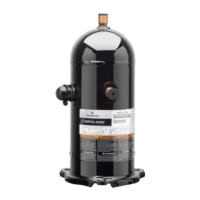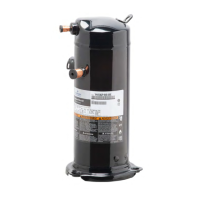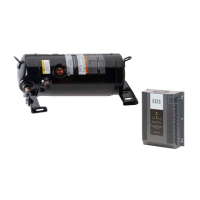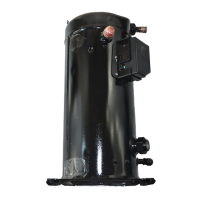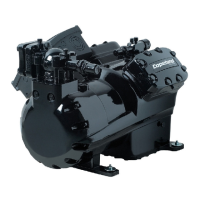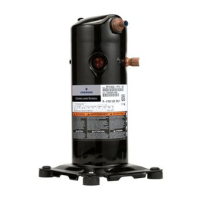36 AGL_HP_VS_YHV_RG_RT_EN_Rev00
6.5.3 Compressor return procedure
If a compressor has to be returned to the manufacturer f or analysis, the refrigerant and the oil have
to be removed completely. For the shipping process, all compressor connections must remain open
and warning stickers for flammable refrigerant must be placed on the shipping box.
During the entire working procedure continuously check if the ambient atmosphere is flammable.
If a flammable atmosphere is detected, ensure proper ventilation of the working space and
immediately cut-off the power supply.
Resume working after the atmosphere is no longer dangerous.
Recover the refrigerant from the system using a suitable recovery unit. During this action, the
compressor crankcase heating function could be energized
immediately de-energize in case a
flammable atmosphere is detected.
Recover to 3 mbar absolute pressure or lower. For best results and to recover also the refrigerant
solved in the oil, run the recovery unit two or three times as necessary.
Flush the whole system with oxygen-free dry nitrogen.
Open the system with a cutting tool and flush the entire system with dry nitrogen.
Disassemble the compressor with a cutting tool. Drain and recover compressor oil properly. Flush
the compressor with dry nitrogen for a few minutes.
The compressor should be returned free of oil and with connections open do not close
connections with plugs.
Collect and secure the oil properly. Provide information about the quantity of oil drained from the
compressor and its colour. Ideally, send a good picture.
Dispose of the oil according to local rules and regulations.
Use a proper cardboard box package when preparing the compressor for shipment. Place
warning icons on each side and on the top of the box. Mention the following message on
the box: "Warning! Flammable A2L or A3 refrigerant compressor for analysis".
The compressor shipment must be kept in the upright position mark it accordingly.
If more than one compressor have to be returned, each compressor must be packed individually.
NOTE: Check with the transport company that all the requirements applying to such
shipments are complied with.
6.6 Lubrication and oil removal
Air/A2L or A3 flammable refrigerant mixture! Flammable and
atmosphere! Fire and explosion hazard! Use suitable recovery unit and
recycling bottles including for oil disposal as A2L or A3 refrigerant may still be
CAUTION
Chemical reaction! Compressor destruction!
Do not mix up ester oils with
mineral oil and/or alkyl benzene when used with chlorine-
ref rigerants.
The compressor is supplied with an initial oil charge
see Table 4. See nameplate f or original oil
charge shown in liters. A field recharge is from 0.05 to 0.1 litre less.
All compressors get a factory holding charge of dry air to prevent humidity entering the compressor
during transport and stocking (about 1 to 2.5 bar, relative pressure). The presence of an intact holding
charge serves as a proof of quality against penetrating moisture.
PAG oil has a similar hygroscopic behaviour to POE (polyolester oil). Only brief exposure to ambient
air is needed for PAG to absorb sufficient moisture to make it unacceptable for use in a refrigeration
system. Since PAG holds moisture, it is more dif ficult to remove it through the use of vacuum.
Compressors supplied by Emerson contain oil with low moisture content, and it may rise during the
system assembling process. Therefore, it is recommended that a properly s ized f ilter dryer be
installed in all PAG systems. This will maintain the moisture level in the oil to less than 50 ppm. If oil
is charged into a system, it is recommended to use PAG with moisture content no higher than
50 ppm.

